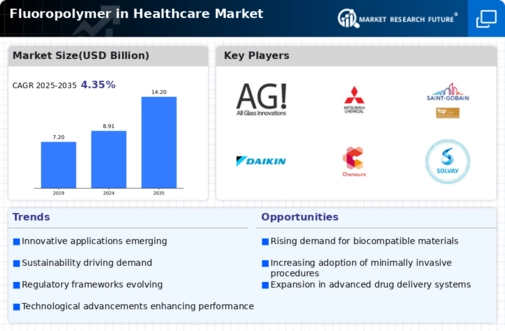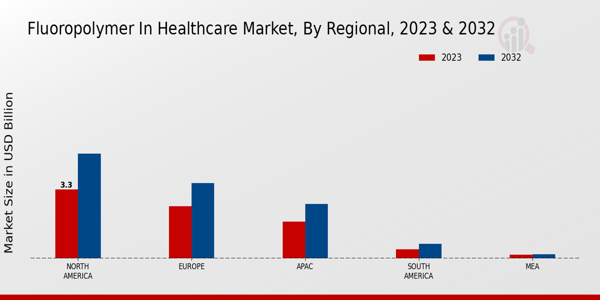Market Growth Projections
The Global Fluoropolymer in Healthcare Market Industry is projected to witness substantial growth in the coming years. With a market value expected to reach 8.91 USD Billion in 2024 and further increase to 14.2 USD Billion by 2035, the industry is poised for a robust trajectory. The compound annual growth rate (CAGR) of 4.35% from 2025 to 2035 indicates a steady increase in demand for fluoropolymer applications in healthcare. This growth is driven by various factors, including technological advancements, regulatory support, and the rising focus on patient safety, which collectively enhance the appeal of fluoropolymers in the healthcare sector.
Increasing Regulatory Support
Increasing regulatory support for the use of fluoropolymers in healthcare applications plays a crucial role in the Global Fluoropolymer in Healthcare Market Industry. Regulatory bodies are recognizing the benefits of fluoropolymer materials, which are often deemed safe for medical applications. This support facilitates the approval process for new products, encouraging manufacturers to invest in fluoropolymer technologies. As the industry evolves, the alignment of regulatory frameworks with technological advancements may lead to a more favorable environment for the growth of fluoropolymer applications in healthcare, further driving market expansion.
Growing Focus on Patient Safety
The growing focus on patient safety is a primary driver for the Global Fluoropolymer in Healthcare Market Industry. Fluoropolymers are increasingly recognized for their non-reactive and non-toxic properties, making them ideal for applications that require high levels of safety and reliability. This trend is particularly evident in the development of implantable devices and drug delivery systems, where material safety is paramount. As healthcare providers and manufacturers prioritize patient outcomes, the demand for fluoropolymer-based solutions is expected to rise, contributing to the industry's projected growth to 14.2 USD Billion by 2035.
Rising Demand for Medical Devices
The Global Fluoropolymer in Healthcare Market Industry experiences a notable surge in demand for advanced medical devices. Fluoropolymers, known for their biocompatibility and chemical resistance, are increasingly utilized in applications such as catheters, surgical instruments, and drug delivery systems. The market is projected to reach 8.91 USD Billion in 2024, reflecting a growing reliance on these materials to enhance device performance and patient safety. As healthcare providers prioritize innovative solutions, the adoption of fluoropolymer-based products is likely to expand, contributing to the overall growth of the industry.
Expansion of Healthcare Infrastructure
The expansion of healthcare infrastructure globally significantly impacts the Global Fluoropolymer in Healthcare Market Industry. Emerging economies are investing in healthcare facilities and services, leading to increased demand for advanced medical technologies. Fluoropolymers, with their unique properties, are well-suited for various healthcare applications, including diagnostic equipment and surgical tools. As these markets develop, the adoption of fluoropolymer materials is likely to grow, supporting the overall market expansion. This trend aligns with the anticipated growth trajectory of the industry, driven by the increasing availability of healthcare services and technologies.
Technological Advancements in Material Science
Technological advancements in material science significantly influence the Global Fluoropolymer in Healthcare Market Industry. Innovations in fluoropolymer formulations enhance their properties, making them suitable for a wider range of healthcare applications. For instance, developments in fluoropolymer coatings improve the performance of medical devices by providing superior lubricity and resistance to wear. This trend aligns with the projected compound annual growth rate (CAGR) of 4.35% from 2025 to 2035, indicating a robust future for fluoropolymer applications in healthcare. The ongoing research and development efforts are expected to yield new products that meet the evolving demands of the healthcare sector.








